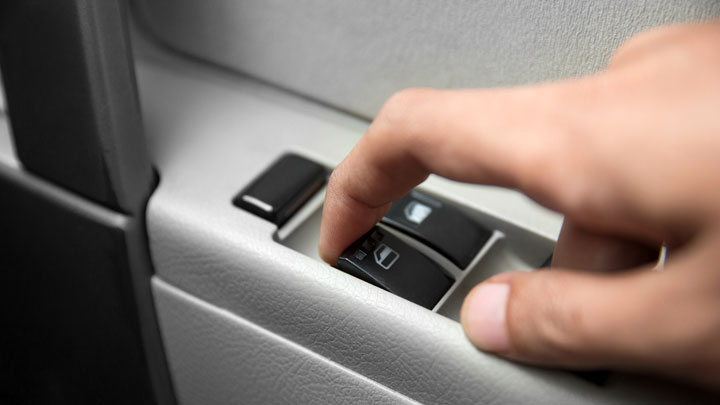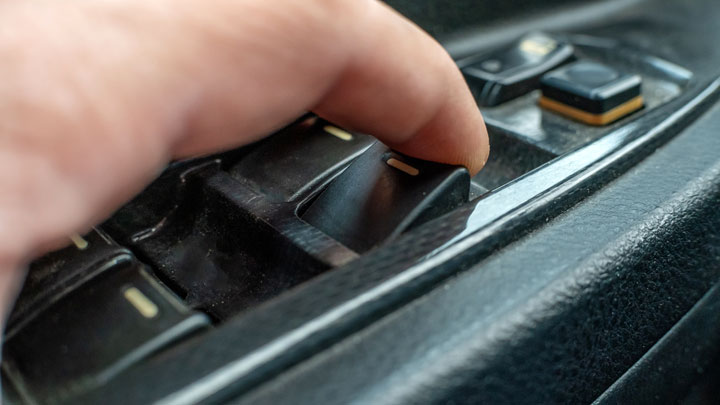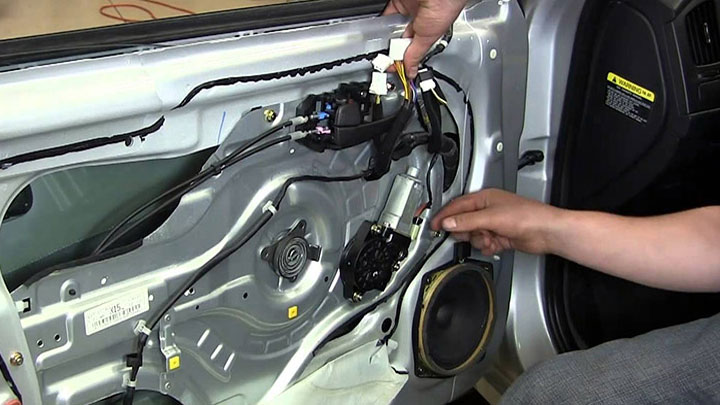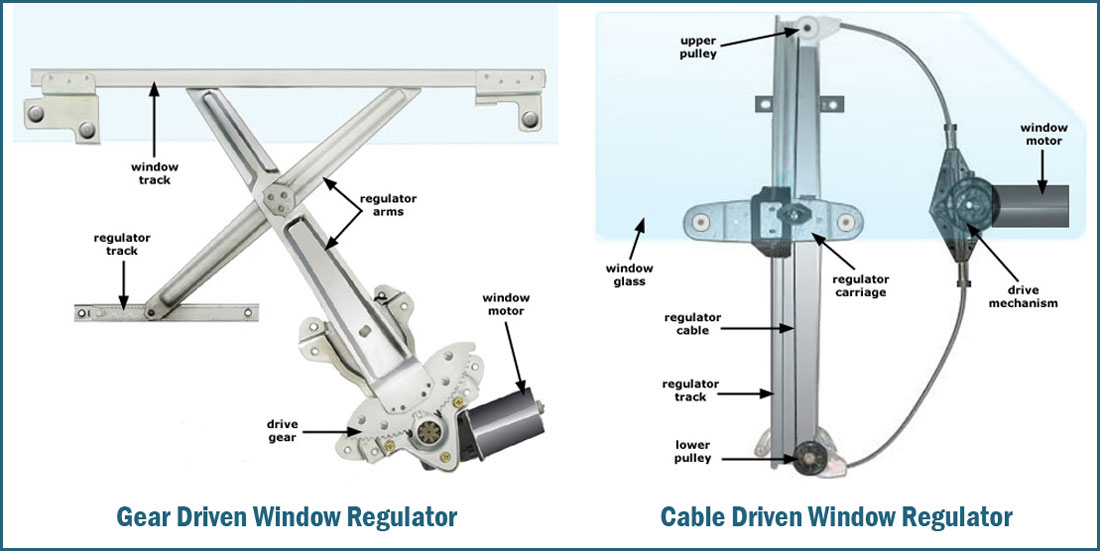Car Window Won’t Go Up? (Causes and How to Fix)
A window stuck open leaves drivers stressed about potential rain or uncomfortable cold. It’s a common nuisance that affects many at some point. The mechanisms allowing up and down movement can fail in various ways, leaving just one direction operable.
Let’s look at the most common causes of a window that won’t roll up, how to fix each, and how to get the window up manually until you get around to fixing it.

Causes of Power Window Failure (and Fixes)
The following are several of the most common power window failures, as well as descriptions detailing how to proceed when each presents itself.
#1 – No Circuit Power
For a power window assembly to operate, it must be supplied with sufficient power. This power is derived from a vehicle’s battery, and is almost always routed through a fuse or circuit breaker, as well as a relay.
If power is interrupted to this circuit, no amount of switch manipulation will raise or lower a window. A window switch must first receive power, before it can distribute it downstream to the awaiting window motor.
How to Fix
In order to address a window circuit power loss issue, the use of a trusty test light will be required. With the corresponding door panel removed, check to see if power is being supplied to the inlet side of your vehicle’s window switch. If your test light does not illuminate, locate the fuse through which this power supply is directed.
In some cases, all windows will be powered on a singular circuit. However, most vehicles divide this power distribution between several circuits. In many cases, a vehicle’s driver side window and passenger side window will be fused separately from its rear windows.
In many instances, a blown fuse or tripped circuit breaker will be located. This is often the product of aging window motors, which have begun to draw too much amperage when in operation.
Related: How Long Do Car Batteries REALLY Last?
#2 – Defective Window Switch

Another common power window circuit failure is that which pertains to the system’s window switch. With time, internal switch contacts begin to deteriorate, therefore not allowing continuity to be established when the switch is manipulated.
Defective switches account for a significant number of power window system failures. However, replacement is not advised until such a condition can be verified.
How to Fix
When attempting to diagnose a failed window switch, the switch unit will need to be removed from its corresponding door panel. A test light or multimeter will also be required in order to obtain a diagnosis.
First, verify that your window switch is receiving incoming power. Your test light should illuminate when power is detected, if properly grounded. Alternatively, 12+ volts should be noted on the circuit’s supply voltage wire with the use of a multimeter.
If incoming power is detected, repeat this process when checking for outlet switch power, with the switch depressed. If no power is observed leaving the outlet side of your window switch, replacement will be required. However, if outlet power is observed, further testing will be necessary at the point of connection with the system’s window motor.
Related: Best Wire Strippers for Automotive Work
#3 – Defective Window Motor

Occasionally, a power window motor will fail, most often as a byproduct of internal circuitry degradation. When this occurs, your window will likely cease to operate in either direction, leaving you in quite the predicament.
Sluggish or noisy window motor operation often serves as a reliable indicator of overall unit health. If a window motor is adequately grounded and supplied with full voltage, yet operates at a snail’s pace, it should be considered suspect.
How To Fix
Luckily, it is relatively simple to diagnose a failed power window motor. To begin this process, remove your door’s interior panel. Next, locate the electrical pigtail which corresponds to the offending window motor. Disconnect the associated plug, and check for the presence of power and ground on the harness side of this connection, while depressing your window switch.
If power and ground are present, your power window motor is faulty and in need of replacement. The difficulty of this job differs from one make and model of vehicle to the next.
Read Also: 13 Types of Vehicle Doors
#4 – Damaged Window Regulator

Much like window motors, regulator units are also prone to failure with age. As time passes, a regulator’s mechanical components begin to fatigue, often leading to irreparable damage. In any event, a faulty window regulator tends to be rather easy to diagnose.
If you have a vehicle window that won’t stay up, seems to be canted to one side, or has fallen into its frame, a failed window regulator is almost certainly to blame.
How To Fix
Diagnosing a faulty window regulator is a matter of visual inspection. By removing your interior door panel, a relatively clear view of this unit is provided.
Thoroughly inspect the regulator’s pivot points, mounts, cables, and window clamps for signs of damage or fatigue. If any irregularity is observed, replacement is advised.
Replacing a window regulator can vary significantly in difficulty, depending upon the particular model of vehicle that is to be repaired. This procedure can range from being simple and straightforward, to extremely tedious. When in doubt, always seek a professional opinion.
Read Also: 4 Ways to Cover a Broken Car Window
How Power Windows Work
Power window systems combine the use of both mechanical and electrical components, in order to facilitate the up and down movement of your vehicle’s windows.
A window switch directs power to a vehicle’s power window motor, which drives the assembly’s regulator. A power window regulator converts the rotational movement of a window motor, into up/down window movement.
Power window regulators come in two distinct forms. The first of these two forms is the parallelogram (gear-driven) regulator, which scissors when in motion, much like a scissor jack. As a window motor cycles, it turns a series of crank gears, which cause the regulator to scissor. As a result, upward thrust is produced.

More recently, many vehicles have begun to employ the use of a cable-driven regulator system. This system winds a cable through a series of pulleys, which is acted upon by the system’s power window motor.
When in operation, this cable is pulled forward and aft, to raise and lower the window to which it is attached.
See Also: How to Remove Window Tint
How to Get a Power Window Up Manually
Mechanical issues always seem to happen at the worst possible time, and those pertaining to your power window system are no exception. If you find yourself in the midst of a trip, and you cannot return your window to the closed position, use the following procedure to rectify the situation.
See Also: 6 Reasons Your Car Door Won’t Shut All the Way
- Remove Door Panel: Begin by removing your vehicle’s interior door panel.
- Disable Window Motor: Disconnect the power supply to your power window motor, and tuck the corresponding pug safely out of the way.
- Disconnect Regulator From Window: You will now unbolt all window-to-regulator fasteners.
- Raise Window By Hand: Placing a palm on each side of the window, gently raise the pane into the upright position.
- Block Window In Place: You will now place 1-2 wooden blocks within the interior compartment of your door, shimming the window in place as a result.
- Reinstall Door Panel: Finally, reinstall your vehicle’s door panel, ensuring that all fasteners are tightened in place.
- P0480 Code (Symptoms, Causes, and How to Fix) - Apr 19, 2024
- Car Temperature Gauge Stopped Working? (Here’s Why) - Apr 15, 2024
- Ignition Coil vs Coil Pack (What’s the Difference?) - Apr 8, 2024

